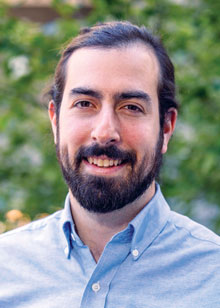Psychiatrist Helps Lead Historic Crisis Services Investment
Abstract
Matthew Goldman, M.D., M.S., is serving as medical director of a major crisis initiative in King County, Wash., where a $1.2 billion investment will create five crisis care centers. He and his colleagues have encouraged psychiatrists to become involved as their communities build out crisis services.
In 2021, as the country was gearing up for the rollout of the 988 Suicide and Crisis Lifeline, a brief titled “Psychiatric Leadership in Crisis Systems” was published that outlined the important role that psychiatrists should play as crisis service medical directors.

“It is clinically very important that psychiatrists are involved in crisis services at the systems level,” said Matthew Goldman, M.D., M.S.
“[T]he role of the [crisis service medical director] within the leadership team is essential in systems seeking to deliver high-quality, safe, and person-centered care,” stated the brief, which was created by the Crisis Services Subcommittee of the Medical Director Institute of the National Council for Mental Wellbeing (Psychiatric News).
In April 2023, voters in King County, Wash., approved a property tax levy to fund the Crisis Care Center Initiative, which is earmarked to create five crisis care centers, restore residential treatment beds, and invest in the county’s behavioral health workforce. Matthew Goldman, M.D., M.S., had recently moved to Seattle around that time. He shared the Psychiatric Leadership in Crisis Systems brief with the county when he inquired about the creation of a medical director role to help lead the initiative. Soon after, Goldman was appointed the initiative’s medical director.
Goldman is a member of APA’s Council on Advocacy and Government Relations. He was a primary author on the brief as a co-chair of the Medical Director Institute’s Crisis Services Subcommittee, along with Sosunmolu Shoyinka, M.D., M.B.A.
As communities across the country build out their crisis services, psychiatrists’ expertise should be harnessed, Goldman said. “In our training, psychiatrists get exposed to a lot of different clinical settings,” he said. “We rotate through emergency rooms, hospitals, and outpatient clinics, and we get a broad sense of how mental health systems and services work. Crisis services have so many intersections with different parts of those systems that we’re very well suited for these roles.”
When patients are in crisis, their medical concerns require significant attention, Goldman continued. Co-occurring or primary medical issues can manifest as psychiatric symptoms. Crisis services should implement protocols and medical stability criteria that utilize the psychiatrist’s knowledge of how psychiatric and medical illnesses manifest, as well as the role that medications can play in crisis situations.
Shoyinka echoed Goldman’s points. Physicians are often pigeonholed into limited, purely clinical roles that do not take advantage of how their knowledge can benefit systems at the macro level, he explained. Shoyinka is a clinical associate professor of psychiatry at the University of Pennsylvania Perelman School of Medicine and the founder of Centia Health, a telepsychiatry company aimed at improving mental health care access to vulnerable populations.
When he served as chief medical officer of the Philadelphia Department of Behavioral Health and Intellectual disAbility Services, Shoyinka led the redesign of Philadelphia’s adult crisis system services. He explained that, when psychiatrists are in leadership roles, they can ensure that complex patients have a clearer path to follow through the system that clinically makes sense. “In the absence of physician leadership, you often end up with arbitrary rules that don’t serve the patients well because they are put into different categories based on superficial criteria,” he said.
The brief that Goldman and Shoyinka helped create as co-chairs of the Crisis Services Subcommittee was intended to serve the purpose for which Goldman used it in King County: To help psychiatrists educate leaders in their communities about how vital psychiatric leadership is within crisis systems. Goldman is now helping to lead the most significant investment in mental health facilities in King County’s history.
“King County is a special place,” Goldman said. “Voters here were willing to approve a property tax that would generate more than $1.2 billion for these services. That’s not something people would be willing to do in many places around the country.”
Like many localities, King County has struggled to connect those experiencing mental health crises with appropriate services. In July 2022, patients waited an average of 55 days for a mental health residential bed, according to a King County news release. In 2021, more than 900 people waited for two days or longer in the county’s hospitals and emergency departments because no mental health treatment beds were available.
Over the past year, Goldman and his King County colleagues have worked with the community to develop an implementation plan for how the tax dollars will be spent, which needs approval by the Metropolitan King County Council. The goal is to open all five facilities by 2030, with the first opening in 2026.
The crisis care centers will have a strong emphasis on integrating care for both mental and substance use disorders, Goldman said. The centers will include behavioral health urgent care units, 23-hour acute observation units, and crisis stabilization units, and they will provide post-crisis care. One center will be devoted specifically to youth in crisis. First responders (including emergency medical technicians, mobile crisis teams, and police officers) can bring individuals directly to the centers as an alternative to emergency departments or jails, but individuals can also walk into the facilities during a crisis.
“This is a dream job,” Goldman said. “Getting to design clinical programs at a systems level with the resources that we need to scale these programs to meet the needs of communities—all while implementing clinical best practices and focusing on equity—is an amazing opportunity. I feel very fortunate.” ■



